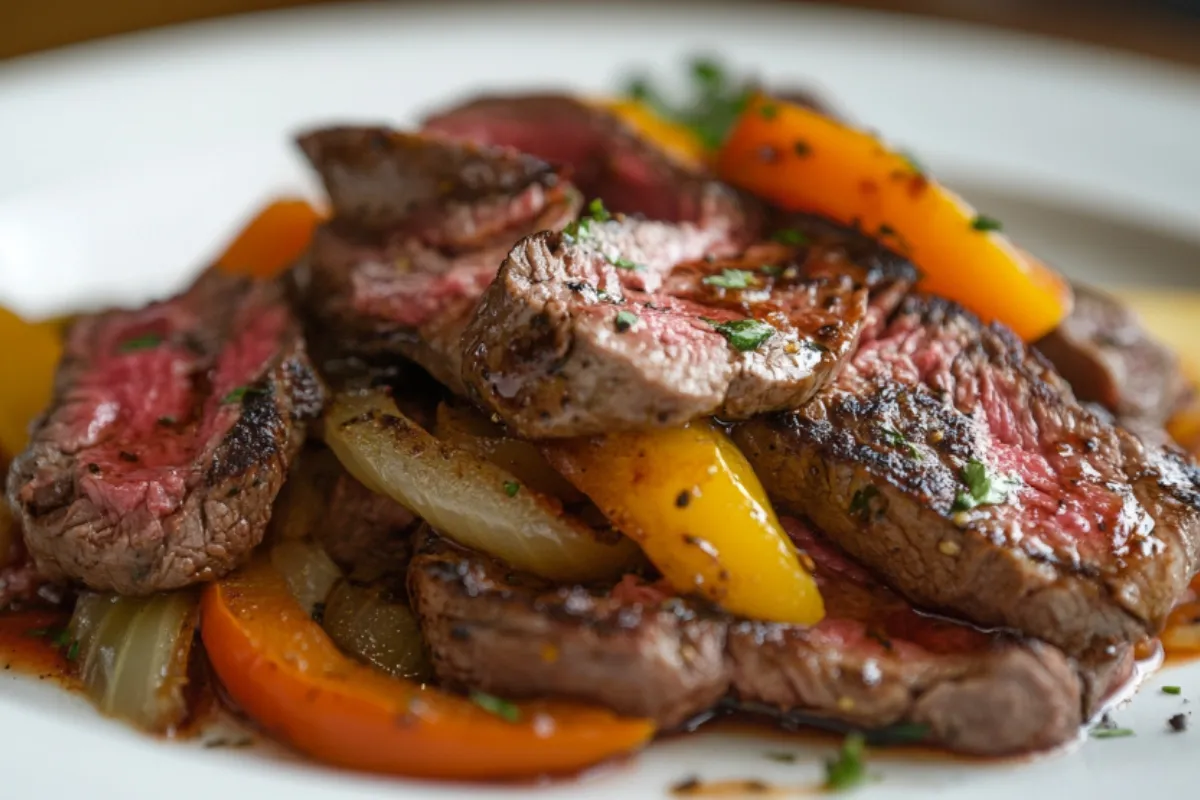What is Pepper Steak?
Pepper steak is a savory dish typically made with thin slices of beef cooked with peppers, onions, and a flavorful sauce. The dish is beloved for its balance of tender beef and the fresh, slightly spicy kick from the peppers. It’s a hearty, satisfying meal that’s easy to make and can be adapted to different cuisines and preferences. Whether served over rice, noodles, or simply on its own, pepper steak is a versatile and flavorful option for any dinner table.
The combination of beef, bell peppers, and soy-based sauces gives pepper steak its signature flavor. The beef is typically stir-fried or sautéed, absorbing all the delicious juices and seasonings, while the peppers provide a crunchy contrast to the tender meat. With a quick cooking time and minimal ingredients, pepper steak is perfect for busy nights when you want something both quick and delicious.
The Origins and Popularity of Pepper Steak
While pepper steak can be found in many cuisines, its most famous iteration is the Chinese-style pepper steak. It’s believed to have been influenced by Chinese stir-fry cooking techniques, which emphasize high-heat cooking and quick preparation. In Chinese cuisine, the dish often incorporates bell peppers, onions, and sometimes even additional vegetables like mushrooms or carrots.
Pepper steak has spread far beyond its Chinese origins, with versions of it found in various global cuisines. In the U.S., it’s a common dish in Chinese-American restaurants, often served with a side of steamed rice. Additionally, the dish has become a popular comfort food, cherished for its simplicity and versatility. Over time, pepper steak has also become a popular dish in countries like Jamaica, where it is often made with a unique blend of seasonings, and in other parts of the Caribbean.
The enduring popularity of pepper steak is due to its ability to be easily modified, from adjusting the spice level to experimenting with different vegetables or sauces. It’s easy to see why it has become such a widely-loved dish.
How Pepper Steak Became a Favorite Dish
Pepper steak’s rise to fame is linked to its ease of preparation and adaptability to different flavors. In Chinese-American cuisine, the dish became a staple due to its quick cooking time and the wide availability of its core ingredients. The combination of soy sauce, garlic, ginger, and black pepper creates a flavorful and aromatic sauce that elevates the simple ingredients of beef and peppers.
Over time, various iterations of pepper steak have emerged, with many chefs and home cooks adding their personal flair. Some like to incorporate brown sugar for sweetness, while others might use hot peppers or chili flakes to turn up the heat. It’s this adaptability and ability to accommodate different tastes that helped pepper steak cement its status as a comfort food across various cultures.
Why Pepper Steak is a Favorite Meal
Flavor Profile of Pepper Steak
What makes pepper steak so universally loved is its complex flavor profile. The dish offers a combination of savory, slightly spicy, and umami-rich flavors, all balanced by the sweetness of peppers and onions. The tenderness of the beef combined with the crunchiness of peppers creates an enticing contrast in texture.
The sauce—usually a mix of soy sauce, garlic, ginger, and black pepper—provides a rich, deep flavor that complements the beef and vegetables perfectly. Some recipes call for a dash of vinegar or brown sugar, which adds a tangy or sweet note to the dish. If you prefer more heat, a sprinkle of chili flakes or fresh hot peppers can add a satisfying kick.
The flavor complexity is part of what makes pepper steak so appealing to so many people. It’s flavorful without being overwhelming, making it a great option for a wide variety of tastes.
Pepper Steak’s Role in Different Cuisines
Pepper steak plays a central role in many cuisines, particularly in Chinese-American and Caribbean cooking. In Chinese-American cuisine, pepper steak is often part of a stir-fry-style dish, served with steamed white rice or fried rice. It’s a favorite in Chinese takeout and has been adapted into countless variations over the years.
In the Caribbean, especially in Jamaica, pepper steak is often prepared with a bolder blend of spices and served with rice and peas or fried plantains. This variation emphasizes the use of local ingredients and spices, showcasing the dish’s adaptability and how it can be influenced by the surrounding culture.
Additionally, pepper steak has become a beloved dish in American homes, where it’s frequently prepared for dinner as an easy yet flavorful meal. It’s also a common offering in restaurants, from casual eateries to fine dining, thanks to its simplicity and ability to please a wide range of palates.
Variations of Pepper Steak Across Cultures
While the basic ingredients of pepper steak remain consistent—beef, peppers, onions, and a savory sauce—the way the dish is prepared and seasoned varies across cultures. For example, in Chinese-style pepper steak, soy sauce, garlic, and ginger are used as a base for the sauce. Caribbean-style pepper steak, on the other hand, may incorporate allspice, thyme, and scotch bonnet peppers for a distinctly bold flavor profile.
In some South American versions of pepper steak, cilantro and lime may be added for a fresh twist. Similarly, in Mediterranean versions, oregano, lemon juice, and even feta cheese could find their way into the dish, offering a lighter, herbaceous flavor.
The great thing about pepper steak is that it’s easily customizable based on what’s available in the kitchen and what flavor profile you prefer. Whether you’re looking for a quick weeknight dinner or a dish to impress guests, pepper steak is a versatile and flavorful choice.
What are the Ingredients for Pepper Steak?
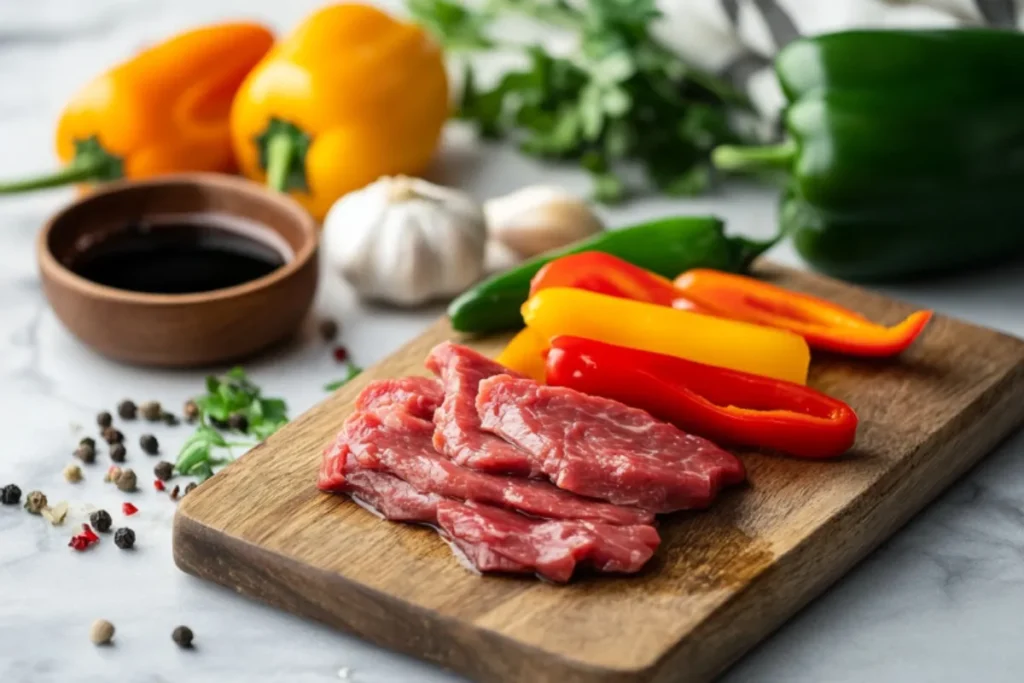
Essential Ingredients for a Traditional Pepper Steak
Pepper steak is a relatively simple dish, but the combination of key ingredients is what makes it so flavorful. Here’s a breakdown of the traditional ingredients you’ll need to make a classic pepper steak:
- Beef: The star of the dish, usually flank steak, sirloin, or round steak are used for their tenderness and quick cooking time. These cuts are ideal for stir-frying and absorbing the flavors of the sauce.
- Bell Peppers: Typically, green bell peppers are used for their crisp texture and slightly bitter flavor, which balances the richness of the beef. You can also add red, yellow, or orange peppers for a more colorful dish with a hint of sweetness.
- Onions: Yellow onions are commonly used in pepper steak, adding a sweet, savory flavor that complements both the peppers and the beef. Some variations also use green onions for a milder, fresher flavor.
- Garlic: Fresh garlic adds a bold flavor to the dish, creating an aromatic base for the sauce.
- Ginger: Fresh ginger is often included in Chinese-style pepper steak, offering a touch of warmth and spice to the sauce.
- Soy Sauce: A key ingredient in the sauce, soy sauce provides a savory, umami flavor that enhances the beef and vegetables.
- Black Pepper: The defining flavor of pepper steak, black pepper adds the signature heat that gives the dish its name. You can adjust the level of heat depending on your taste.
- Cornstarch: Often used to thicken the sauce, cornstarch is dissolved in water or broth and added to the mixture to create a glossy, flavorful sauce.
- Sugar: A touch of brown sugar or granulated sugar is sometimes added to balance the saltiness of the soy sauce and to enhance the caramelization of the beef.
If you’re looking for more delicious beef recipes, Garlic Butter Ribeye Steak makes for a fantastic alternative or side dish. The rich flavors and juicy texture of ribeye steaks complement pepper steak perfectly.
Different Types of Peppers in Pepper Steak
While green bell peppers are the traditional choice for pepper steak, there are other peppers you can use to add variety or to enhance certain flavors:
- Red Bell Peppers: These peppers are sweeter than green ones and add a pop of color to the dish. Using a combination of red and green peppers can add depth to both the flavor and the presentation of the dish.
- Hot Peppers: For those who like a bit of heat, jalapeños or serrano peppers can be added to the dish for an extra spicy kick. Be sure to remove the seeds if you prefer a milder heat.
- Poblano Peppers: These add a rich, smoky flavor to the dish and can pair well with the beef, especially in variations that lean more toward Tex-Mex or southwestern styles.
The beauty of pepper steak is that you can experiment with different types of peppers depending on the flavor and spice level you want to achieve.
How to Choose the Right Vegetables for Pepper Steak
In addition to bell peppers, other vegetables can be added to pepper steak to enhance the flavor and texture of the dish. Here are some ideas:
- Mushrooms: Adding sliced mushrooms can provide an earthy flavor and a meaty texture that complements the beef. Mushrooms are a great addition, especially if you’re making a larger batch or want to add more umami flavor.
- Snow Peas or Snap Peas: These peas add a nice crunch and a touch of sweetness, which balances the savory beef and peppers. They also bring a beautiful pop of color to the dish.
- Carrots: Thinly sliced carrots can be added for a touch of sweetness and extra crunch. They pair well with the bell peppers and beef, giving the dish more complexity.
The vegetables you choose will depend on your personal preference and what’s in season. The key is to ensure that the vegetables are cooked just enough to maintain their texture and flavor, without overpowering the beef.
What is the Best Cut of Meat for Pepper Steak?
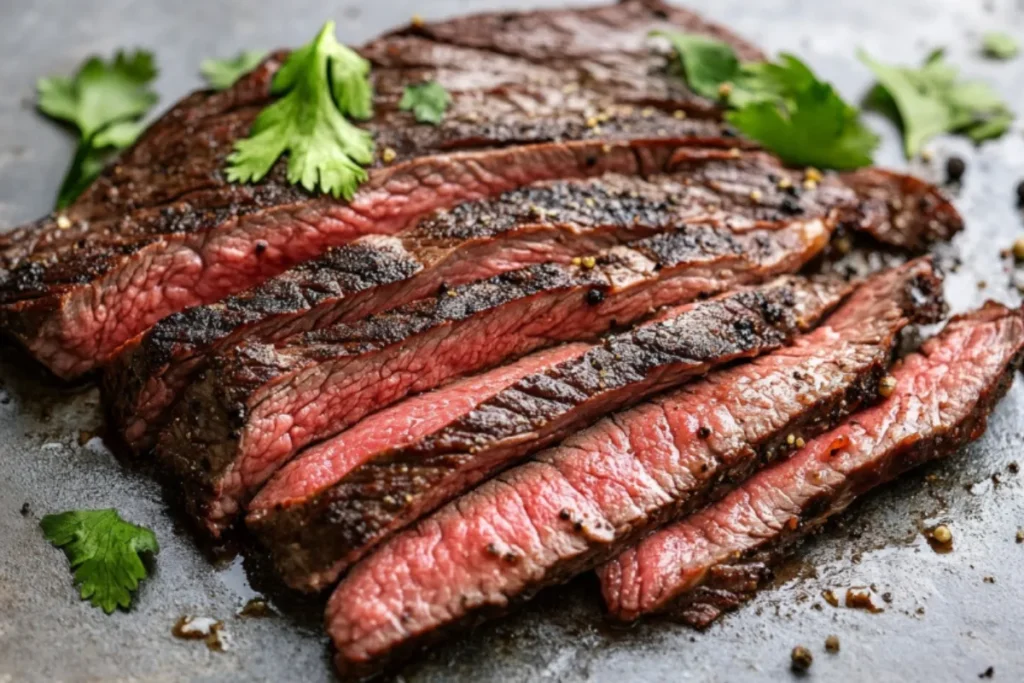
Best Cuts of Beef for Pepper Steak
The best cuts of meat for pepper steak are those that are tender and cook quickly. Here are a few options:
- Flank Steak: This is the most commonly used cut for pepper steak. Flank steak is lean, flavorful, and becomes very tender when sliced thin against the grain. It’s perfect for stir-frying and absorbing the flavors of the sauce.
- Sirloin Steak: Another great option, sirloin is a little more tender than flank steak and has a nice balance of flavor. It’s often used in many stir-fry dishes, including pepper steak.
- Round Steak: While not as tender as flank or sirloin, round steak can still work well in pepper steak, especially if it’s sliced thin and cooked quickly. You may need to marinate it longer to help tenderize it.
- Tenderloin: For a truly premium version of pepper steak, tenderloin provides the most tender meat. It’s more expensive but gives an ultra-smooth texture.
For another beef-based dish, check out Black Pepper Chicken: A Flavorful & Easy Meal. It’s a simple yet delicious recipe that can be easily adapted to make pepper steak with chicken instead of beef.
Tender vs. Tough Cuts: What to Know
When making pepper steak, it’s important to consider the tenderness of the meat. Tender cuts like flank, sirloin, and tenderloin are ideal because they cook quickly and remain juicy when thinly sliced. Tougher cuts of beef, like round steak, require a bit more attention to make them tender. Marinating the meat or slow-cooking it beforehand can help make tougher cuts more palatable.
Alternatives to Beef for Pepper Steak
Pepper steak doesn’t have to be made with beef! For a different twist, you can substitute the beef with:
- Chicken: Thinly sliced chicken breast or chicken thighs can be used to make a lighter version of pepper steak. Chicken’s mild flavor makes it a great base for the bold pepper sauce.
- Pork: Pork tenderloin or pork shoulder can also work well in pepper steak. Pork has a slightly sweeter flavor than beef, which pairs nicely with the savory sauce.
- Tofu: For a vegetarian or vegan option, tofu can be used instead of meat. Press the tofu to remove excess moisture, then cut it into thin slices and stir-fry with the peppers and sauce.
Cooking Pepper Steak
Why is Chinese Pepper Steak So Tender?
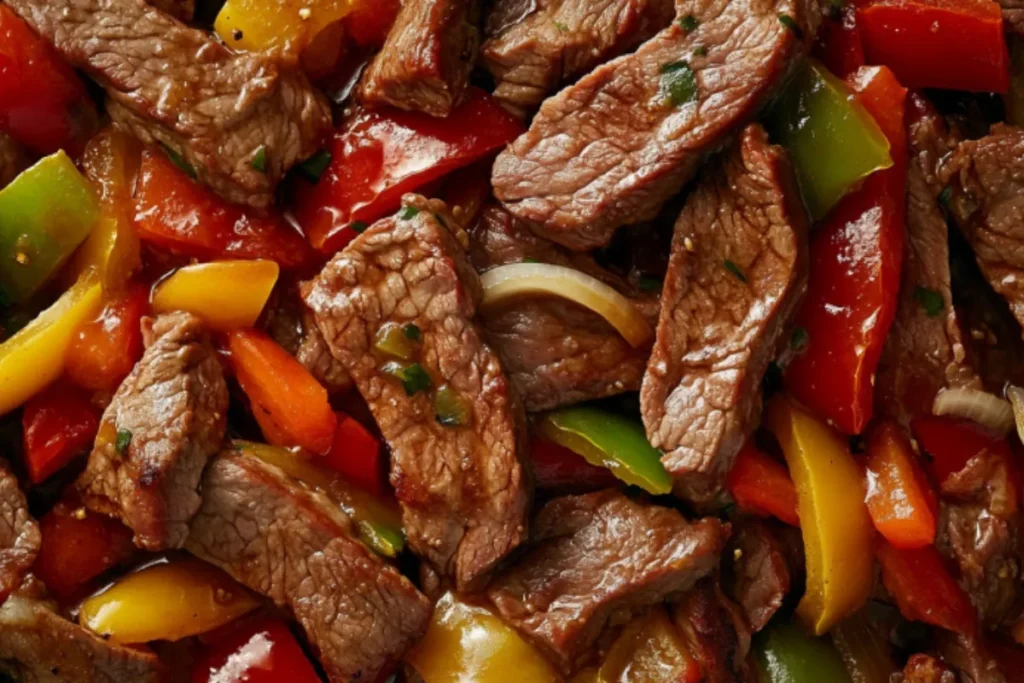
Chinese-style pepper steak is known for its incredible tenderness, and this quality is largely due to a few key techniques. The first is the use of a marinade that helps tenderize the meat before cooking. The marinade typically includes ingredients like soy sauce, cornstarch, and rice vinegar, which not only enhance the flavor but also break down the fibers in the meat, making it more tender. This technique is often referred to as velveting, a process used in Chinese cooking to keep meat tender during stir-frying.
Additionally, high-heat cooking methods help lock in moisture and prevent the meat from becoming tough. Cooking the beef quickly in a hot pan allows it to stay juicy while still achieving a crispy, caramelized exterior. The combination of marinating and quick, high-heat cooking methods creates a tender, flavorful pepper steak that’s cooked to perfection.
The Role of Marinades in Tenderizing Meat
Marinating meat before cooking is a popular method for ensuring tenderness, especially in tougher cuts. For pepper steak, a simple marinade consisting of soy sauce, ginger, garlic, and cornstarch can do wonders. The cornstarch in the marinade coats the meat and helps retain moisture while cooking. The acid in the marinade (often from vinegar or citrus like lime) helps to break down the muscle fibers, making the meat more tender and flavorful.
When marinating, it’s essential to let the beef sit for at least 30 minutes, though marinating for a few hours will yield even better results. Marinating overnight in the fridge can result in an even more flavorful and tender steak.
How High Heat Cooking Methods Help Tenderness
When cooking pepper steak, high-heat methods like stir-frying or pan-searing are essential for achieving both tenderness and flavor. Stir-frying, for example, involves cooking the beef quickly in a hot pan, which sears the outside while keeping the inside moist and tender. The fast cooking time prevents the beef from becoming overcooked, which would cause it to toughen up.
In addition, high heat allows for the Maillard reaction—a chemical process that creates a rich, brown crust on the meat and adds depth of flavor. This technique not only keeps the beef tender but also enhances the overall taste of the dish.
Key Techniques for Cooking Tender Pepper Steak
To ensure that your pepper steak turns out tender, follow these key techniques:
- Marinate the Beef: Use a marinade to tenderize and flavor the beef. Allow it to marinate for at least 30 minutes (or overnight for the best results).
- Slice the Beef Thinly: For the best texture, slice the beef against the grain into thin strips. This helps break down the muscle fibers and ensures a tender bite.
- Use High Heat: Stir-fry the beef in a hot pan or wok to lock in moisture and achieve a crispy, flavorful exterior while keeping the inside juicy.
- Don’t Overcook: Overcooking can lead to tough meat. Cook the beef just until it’s browned on the outside and slightly pink on the inside. If you’re unsure, use a meat thermometer to ensure it’s cooked to perfection (aim for 145°F for medium-rare).
Do You Cook Peppers or Steak First?
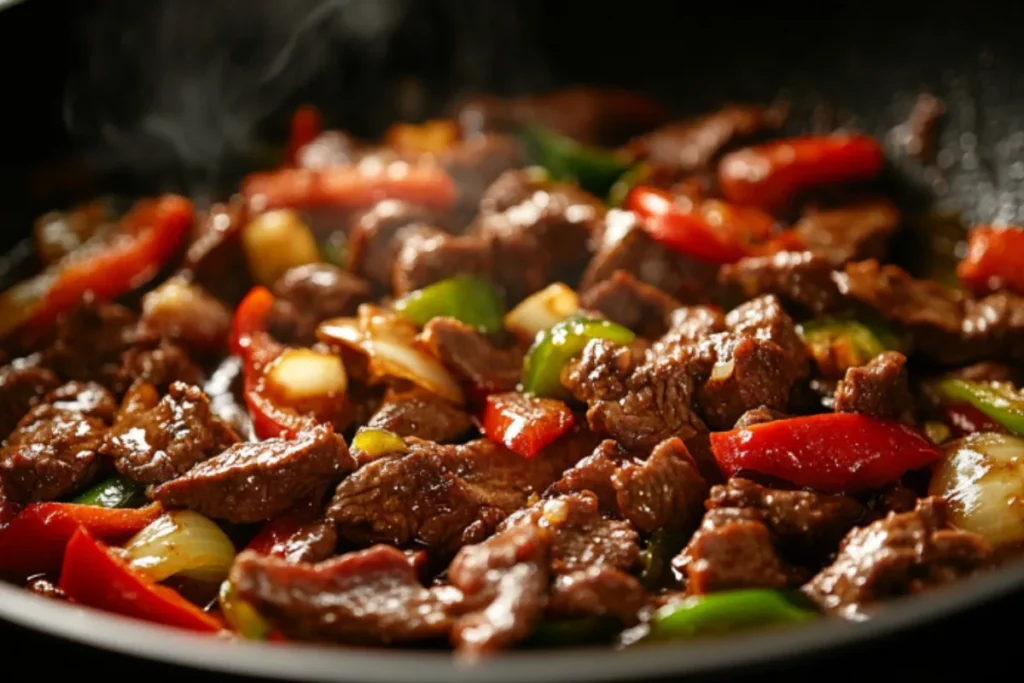
The Best Order for Cooking Pepper Steak
One of the key decisions when cooking pepper steak is whether to cook the peppers or steak first. The answer depends on your cooking method and the texture you’re aiming for, but the general rule of thumb is to cook the steak first. Here’s why:
- Cook the Steak First: When cooking pepper steak, it’s ideal to cook the steak first. This allows the beef to brown and caramelize, which adds depth to the flavor. Once the beef is cooked, remove it from the pan to rest while you cook the vegetables. This also prevents the beef from overcooking.
- Cook the Peppers Last: After removing the beef from the pan, cook the peppers and onions. Peppers cook relatively quickly and should remain slightly crunchy for the best texture. Cooking the vegetables last ensures they’re fresh, bright, and not overcooked.
How to Ensure Both Meat and Peppers Are Perfectly Cooked
To ensure that both the meat and peppers are cooked to perfection, follow these tips:
- Stir-Fry in Batches: If you’re making a large batch, don’t overcrowd the pan. Cook the steak in batches to allow the beef to brown evenly. The same goes for the peppers—cooking in batches ensures everything is cooked properly.
- Control the Heat: When cooking the steak, make sure the pan is very hot before adding the meat. This helps achieve a good sear. When cooking the peppers, reduce the heat slightly to avoid burning them while ensuring they still cook through and retain some crunch.
- Combine at the End: Once both the beef and peppers are cooked, return the beef to the pan with the vegetables and quickly toss everything together to combine. This will allow the beef to absorb some of the peppery flavors while keeping the peppers crisp.
FAQs
What are the ingredients for pepper steak?
The essential ingredients for pepper steak include beef (flank steak or sirloin are common choices), bell peppers (usually green, but other colors can be used), onions, garlic, soy sauce, ginger, and black pepper. Additional ingredients like cornstarch for thickening, brown sugar for sweetness, and vinegar for acidity are often added to the sauce. The combination of these ingredients creates the signature savory, slightly spicy, and umami-rich flavor of pepper steak.
What is the best cut of meat for pepper steak?
The best cuts of beef for pepper steak are flank steak, sirloin, and round steak. These cuts are tender enough for quick stir-frying and have good flavor. Flank steak is particularly popular because it’s lean and flavorful, and when sliced thin against the grain, it’s tender and easy to chew. If you prefer a more tender cut, tenderloin works as well, though it’s pricier.
Why is Chinese pepper steak so tender?
Chinese pepper steak is tender primarily due to the use of a marinade that helps break down the muscle fibers in the beef, making it more tender. The marinade often contains soy sauce, cornstarch, and a bit of vinegar or rice wine, which together not only enhance the flavor but also soften the meat. Additionally, high-heat stir-frying helps lock in the moisture, keeping the beef juicy and tender while achieving a crispy exterior.
Can I make pepper steak with chicken instead of beef?
Yes! You can easily make a chicken pepper steak by swapping out the beef for chicken breast or chicken thighs. Slice the chicken thinly against the grain, and follow the same cooking process. The flavor profile remains similar, and chicken will absorb the sauce and seasonings well, making it a great alternative if you’re looking for a lighter version of the dish.
Can I make pepper steak ahead of time?
Absolutely! Pepper steak can be made ahead of time and stored in the refrigerator for up to 2-3 days. In fact, the flavors may even improve as they meld together. To reheat, simply warm it up on the stove or in the microwave. If you’re preparing it ahead of time, make sure to slightly undercook the peppers so they retain their crispness when reheated.
For more insights on the nutritional benefits of the ingredients used in pepper steak, or for additional tips on healthy eating, you might find valuable information on Healthline. Understanding the nutritional profile can help you tailor the recipe to your specific dietary needs.
What is a good side dish to serve with pepper steak?
Pepper steak pairs beautifully with steamed rice, fried rice, or noodles, which soak up the delicious sauce. You can also serve it with roasted vegetables, sautéed greens, or a simple side salad to balance the richness of the dish. For a more indulgent side, garlic bread or mashed potatoes also make a great complement to the savory flavors of the steak.
Can I add other vegetables to pepper steak?
Yes, you can definitely add other vegetables to pepper steak! Mushrooms are a great addition and provide an earthy flavor. Carrots, snow peas, and broccoli also work well in the dish. Just make sure to cook the vegetables in the proper order to maintain their texture—vegetables like bell peppers and onions cook quickly, while heartier vegetables like carrots or broccoli may need a bit more time to soften.

